... After a few quieter weeks, another swarm of tremors shook the area on November 23, prompting media to again speculate about the likelihood of magma rising to the surface.
...
Tension among residents has remained high because scientists don’t know for sure what’s going on under the surface. The scientific community agrees that the tremors and uplift are signs that the volcano is awakening. But they are struggling to rectify two competing explanations for the bulging ground that have been debated for decades, leaving residents and researchers uneasy. An answer to the geological mystery could bring scientists much closer to determining how likely the volcano is to blow. It could also provide geologists worldwide with warning signs they could look for when other big volcanoes start rumbling, especially supervolcanoes such as Yellowstone in the northwestern U.S., Toba in Indonesia and the Altiplano-Puna volcanic complex in Argentina, Bolivia and Chile.
One model—let’s call it the shallow magma model—posits that the seismicity and bulging are caused by magma pushing to break through the surface, making an explosive eruption, with violent magma outflow highly likely in the near term. Alternatively, in the hot fluids model, steam and hot gases released by magma located deeper underground are to blame. In that case, the ongoing seismic activity could stop abruptly or peak in a phreatic eruption—the volcano would spurt out hot liquids, gases and rock fragments instead of lava. This would pose a lesser threat, although it would still be a lethal one because so many people live close by.
...
The volcano, known as Phlegrean Fields in English, comprises two dozen craters and other structures in an area 14 kilometers across. One third of it lies under the Tyrrhenian Sea, between the Italian mainland and the country’s island of Sardinia. The volcano has been active for at least 80,000 years. Its caldera—the depression created when emptying magma chambers cause the roof of a volcano to collapse—formed after two violent eruptions 39,000 and 15,000 years ago. The older one caused a volcanic winter in areas within 100 km, sent ash as far away as Russia and abruptly cooled the climate around the world.
After its most recent eruption in 1538 the volcano went quiet. By now, “any previous connection between the molten rock underground and the surface has been sealed up,” says Christopher Kilburn, a volcanology and geophysical hazards professor at University College London. As a result, the crust serves as a barrier, and Kilburn says that before another eruption can take place, the crust has to be ruptured, creating a new pathway for lava or fluids to breach.
Scientists think that has been happening since Campi Flegrei awakened in the 1950s. ...







